![]()
View a three part video
presentation on the history of the Orthodox Church,
provided on YouTube
by GOTelecom.
Part 1: Beginnings
Part 2: Byzantium
Part 3: A Hidden Treasure
(Click the links above to view the videos. Each video will open in a new browser
window.)
1.
The Early Orthodox Church
2. Orthodoxy in America
3. The Greek Orthodox Church in America
4. The Orthodox Church Today
Orthodoxy dates from the founding of the Church on the Glorious Day of the Pentecost, 33 A.D., fifty days after the Lord's Resurrection. Anointed by the Holy Spirit, the Holy Apostles went forth to establish churches throughout the Middle East. St. Paul, the most dynamic of the Apostles, traveled west, founding churches in Asia Minor, Greece, and ultimately Rome.
Centuries later, Emperor Constantine I (the Great) moved the capital of the Roman Empire to Byzantium, which he renamed Constantinople, and in 323 declared Christianity the official religion of the empire. The early Church was made up of five autocephalous (self-governing) dioceses: Antioch, Jerusalem, Alexandria, Constantinople, and Rome, whose bishop was considered primus inter pares, or "first among equals." These dioceses (later known as patriarchates) cooperated as one faith until the Great Schism of 1054, when Rome separated from the other four patriarchates. The eastern patriarchates remained united as the Eastern Orthodox Church.

Icon of the Pentecost. The icon depicts the Twelve Apostles gathered in the upper room fifty days after the Resurrection of Jesus Christ, and ten days after His Ascension into Heaven. Each Apostle has a small red flame above his head, representing the Descent of the Holy Spirit upon them. The figure at the bottom of the icon is Cosmos (literally, "The World"). He represents the world emerging from darkness into Light. In the cloth, Cosmos carries twelve scrolls, representing the Good News each Apostle carried to the world. Pentecost in the Orthodox church is celebrated fifty days after Pascha (Easter).
![]()
Icon of the Saints of North America.
Click the image to learn more.
Icon and information from the the
Orthodox Church in America's web site.
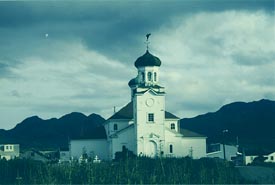
Holy
Ascension of Our Lord Cathedral, Unalaska, Alaska, built in
1824. One of the oldest extant Orthodox churches on the
North American continent.
Click the photo to learn
more.
Photo
courtesy Orthodox
Church in America,
used with permission.
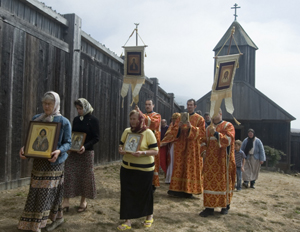
Procession from the Fort Ross chapel to the fort's cemetery. The Fort Ross chapel was built in the mid-1820s and is the first Orthodox church building on the North American continent built outside of Alaska.
Photo courtesy Fort Ross State Historic Park, Sonoma County, California, and California Department of Parks and Recreation, used with permission. Click the image for a larger view.
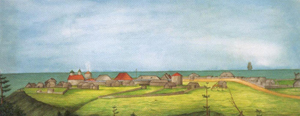
Settlement Ross, 1841, by Russian naturalist and artist Ilya Gavrilovich Voznesenskii. showing the Fort Ross chapel. Image courtesy Fort Ross State Historic Park, Sonoma County, California, and California Department of Parks and Recreation, used with permission. Click the image for a larger view.
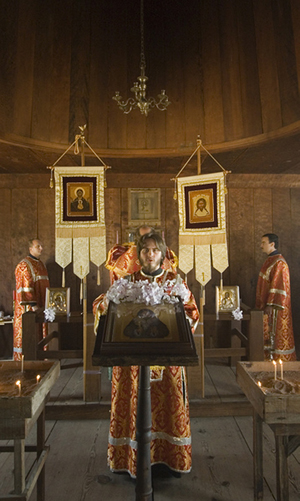
Divine Liturgy served in the Fort Ross chapel.
Photo courtesy Fort Ross State Historic Park, Sonoma County, California, and California Department of Parks and Recreation, used with permission.
2.
Orthodoxy in America I:
The Russians
Orthodoxy first arrived in the Americas in 1794 when Russian missionaries founded a church in Novoarkhangelsk (now Sitka), Alaska. The Russian missionary field extended from Alaska to San Francisco, California, covering much of the Pacific Northwest, and included the establishment in what is now Sonoma County of a Russian/Native Alaskan settlement at Fort Ross, California. The Fort Ross (short for Rossiya, "Russia") chapel, originally commemorating St. Nicholas, was the first Orthodox church building built on the North American continent outside of Alaska. The Church later expanded eastward into the United States and Canada as immigrant communities organized parishes. The Orthodox Church in North America was originally under the jurisdiction of the Church of Russia, and would likely have remained so were it not for the Bolshevik Revolution in 1917.
The revolution in Russia and its tragic aftermath threw the evolution of an American Orthodox Church into disarray. The situation was further complicated by a twenty year flood of immigrants into the United States from Eastern Europe and the Balkans which created a patchwork of Orthodox churches in American cities serving their own ethnic communities. As a result of the Bolshevik Revolution, these communities retreated into the jurisdictions of the national churches of their home countries. This is why, in some large cities, you will find many jurisdictions represented. Despite the multiple jurisdictions, the Orthodox Church remains liturgically and doctrinally one Church. In recent years, there has been movement towards the creation of an American Orthodox Church to replace the multiplicity of jurisdictions.
The Orthodox Church in America (OCA), an offshoot of the Russian Orthodox Church, has published a book about the history of Orthodoxy in America and makes it available for online reading. To read this book, Orthodox Christians in North America, 1794-1994, click this link. The book is also available in print. Purchasing instructions are on the opening page.
The Library of Congress has made documents from the Alaskan Russian Church Archives available for online viewing. The exhibit, In the Beginning Was the Word: The Russian Church and Native Alaskan Cultures, is a rich treasure-trove of primary source documents, drawings, and photographs from an often neglected area of American history.
Native American Public Telecommunications (NAPT) has produced Aleut Story, a documentary film concerning the internment of Alaskan natives: "In 1942, as World War II invaded Alaska, Aleut Americans were taken from their homes and removed to abysmal government camps 1,500 miles away. Death was ever-present in the camps. An estimated 10 percent of the men, women and children sent to the camps would die there... As the Aleuts prayed for deliverance, 'friendly forces' looted their homes and churches in the Aleutian and Pribilof islands. Those who survived would fight for their rights...In a historic action -- one that continues to influence our lives and our nation's ideals -- Aleuts joined Japanese Americans in seeking wartime reparations from the federal government. Aleut Americans ultimately prevailed." -- from the Aleut Story web site. Purchasing instructions are on the NAPT web site.
The Russian Orthodox Diocese of Alaska (OCA) has recently opened the Russian Orthodox Museum in Anchorage. The museum seeks to preserve, exhibit, and interpret the heritage and history of the Orthodox Church in Alaska as it has existed from the eighteenth century to the present. Exhibits include restored artifacts, rare icons believed to have been painted in the Sitka school of iconography, and beaded priests' vestments designed and sewn by the late Tlingit artist Emma Marks.
In 2012, Fort
Ross State Historic Park, the Fort
Ross Interpretive Association and the Fort
Ross Conservancy celebrated the bicentennial
of the establishment of Fort Ross in Sonoma County, California.
Invited dignitaries included the President of
the United States, the Governor of California, the Prime Minister
of Russia, and representatives of the Kashaya tribe. The bicentennial
observances include worldwide traveling exhibits which began
in 2011. A web site for the bicentennial of Fort Ross can
be viewed at www.fortross200.org,
and additional information may be found at www.fortross.org/bicentennial-2012.
General information about the park, including brochures, photos,
and videos, can be viewed here.
In addition, the San Francisco Diocese of the Orthodox Church
in America serves
the Divine Liturgy at the Fort Ross chapel twice yearly on
Memorial Day and July 4th. On
August 25, 2012, a Hierarchical Divine Liturgy was held at
Fort Ross to celebrate the bicentennial. An article is
available on the OCA website, with picture galleries. Finally,
the California State Parks Foundation has published an interactive
ebook entitled
Russian
California: Hidden Stories from Fort Ross and Beyond,
which is available free from Apple's
iTunes Store. Note: this ebook is available for iPad
only.
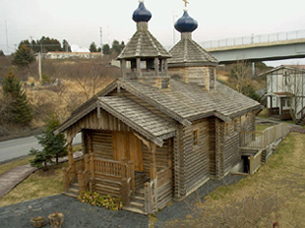 |
All Saints of Alaska Chapel is a replica of a Russian mission church built in 1795. The chapel is located on the campus of St. Herman of Alaska Orthodox Theological Seminary in Kodiak, Alaska. Similar designs are often found in Alaskan mission churches from the 18th century. Log churches were common in Russia, and some have been preserved as part of the artistic and cultural heritage of Russia,. Click on the image to view the interior of the chapel in a new browser window. Use your browser's close function to return to this page. Photo courtesy of the Russian Orthodox Diocese of Alaska, OCA. |
3.Orthodoxy in America II:
The Greeks
In 1864, Greek merchants in New Orleans established Holy Trinity Church (at right), the first Greek Orthodox Church in America. Nearly thirty years passed until the next churches were formed, in New York City and Chicago. The arrival of more than 350,000 Greek immigrants in the first two decades of this century stimulated the rapid establishment of Greek parishes -- by 1923, there were 140 churches in the U.S.
Today, 444 churches in this country, with approximately two million members, are part of the Greek Orthodox Archdiocese of America, headquartered in New York City. The Archdiocese is administered by a Synod of Bishops, presided over by Demetrios, Archbishop of America. In turn, the Archdiocese is under the spiritual leadership of Bartholomew I, the Ecumenical Patriarch of Constantinople.
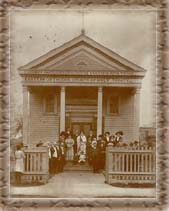 Holy Trinity Church, circa 1865, New Orleans. Holy Trinity was the first Greek church established in North America. |
 Holy
Trinity Cathedral today. Holy
Trinity Cathedral today.This cathedral is the successor to the original Holy Trinity church. This photo was shot before Hurricane Katrina flooded New Orleans in 2005. Holy Trinity also operates a smaller "satellite church" in Baton Rouge. |
| Photos courtesy of Holy Trinity Cathedral, used with permission. | |
4.Orthodoxy
in America III:
The Antiochians
Coming Soon!
Today, 300 million people throughout the world are Eastern Orthodox Christians. The 14 autocephalous Orthodox churches are independently administered and conduct services in dozens of native languages, yet, whether in Athens, Moscow, or Des Moines, all Orthodox Christians share the same teachings, sacraments, and liturgies and honor the Patriarch of Constantinople as their spiritual guide.